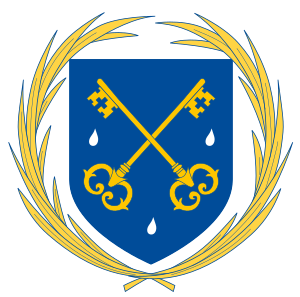Priestly Fraternity of St. Peter

The Priestly Fraternity of St. Peter (Latin: Fraternitas Sacerdotalis Sancti Petri; for short: F.S.S.P.) is a group of Catholic priests and seminarians who want to say the Mass and other sacraments the way they were said before the Second Vatican Council.
Church laws
According to the laws of the Catholic Church, the F.S.S.P. is a "Clerical Society of Apostolic Life of Pontifical Right".[1] This means that members have to follow the same rules as diocesan clergy and also swear an oath as members of the Society.[1] The Fraternity was established by the Pope, and local bishops are not allowed to tell the Fraternity what to do. Instead, the Pope is in charge of them, through an organization called Ecclesia Dei.[2] A local bishop is still in charge of the Fraternity's work within his own diocese.
Purpose
The members of the F.S.S.P. are priests and seminarians who want to express their faith in a specific way. This way is to offer the Mass and other sacraments using the Roman Rite, the way it was before it was changed after the Second Vatican Council.[3] Because of this, the Fraternity uses books of worship from the year 1964, including the Roman Missal, the Roman Breviary, the Pontifical (Pontificale Romanum), and the Roman Ritual.
The Fraternity has two purposes: make their priests become holy people, and to send these priests to parishes.[1][4] They celebrate the sacraments, teach people about Catholicism, give retreats, organize pilgrimages, and provide a full sacramental and cultural life for Catholics who also want to use the liturgy of the 1962 missal.[1] The Fraternity has built its own seminaries to train their own priests to do these things.
Founding
The F.S.S.P started with members of the traditional Catholic group, the Society of St. Pius X (S.S.P.X.). In 1988, Archbishop Marcel Lefebvre wanted to make four priests from the S.S.P.X. into bishops. Pope John Paul II did not let him do it, but he did it anyway. The Pope and the Congregation of Bishops said that this was a schismatic act, which meant that the S.S.P.X. was not part of the Catholic Church any more.[1][5][6] Twelve priests and several seminarians, led by Father Josef Bisig, did not agree with the decision of Archbishop Lefebvre, and started the F.S.S.P as their own group on July 18, 1988. Father Josef Bisig became the Fraternity's first superior general.
Organization
In 2011, the Fraternity had 392 people in it: 228 priests, 10 deacons, and 154 seminarians in 117 dioceses around the world. There are people in the Fraternity from 35 countries.[7] There is also a group of lay members called the Confraternity of Saint Peter with 3,487 people in it.[8]
Superiors General
The person in charge of the F.S.S.P. is called the superior general. The Very Reverend Andrzej Komorowski is the superior general right now. He is helped by the Vicar General and Assistant, the Very Reverend Patrick du Faÿ.[9]
- Josef Bisig (1988–2000)
- Arnaud Devillers (2000–2006)
- John Berg (2006–2018)
- Andrzej Komorowski (2018–present)
Districts and regions
The Fraternity has people all over the world, so people in different parts of the world are split into three districts and two regions:[9][10]
- German-speaking District, Superior: Rev. Axel Maußen
- French District, Superior: Rev. Vincent Ribeton
- North American District, Superior: Rev. Eric Flood
- Belgium-Netherlands Region, Superior: Rev. Hervé Hygonnet
- Southern Cross Region, Superior: Rev. Christopher Blust
Educational institutions
The Fraternity has two seminaries:[1]
- The International Seminary of St. Peter is in Wigratzbad-Opfenbach, Bavaria, Germany. It was started in 1988 and teaches students who speak French and German.
- Our Lady of Guadalupe Seminary is in Denton, Nebraska, USA. It was started in 1994 and teaches students who speak English.
It also runs Ezekiel House, a house for seminarians who have studied for less than one year, in Sydney, Australia.
Priestly Fraternity Of St. Peter Media
Members of the fraternity celebrating Solemn Mass
References
- ↑ 1.0 1.1 1.2 1.3 1.4 1.5 "What are we?". The Priestly Fraternity of Saint Peter. June 9, 2010. Retrieved June 10, 2010.
- ↑ "Decree erecting the Priestly Fraternity of Saint Peter, 18 October 1988". Documents. Priestly Fraternity of Saint Peter. October 18, 1988. Retrieved June 10, 2010.
- ↑ "History of the North American District". What are we?. Priestly Fraternity of Saint Peter. June 9, 2010. Retrieved June 10, 2010.
- ↑ "Excerpt of the Constitutions of the Priestly Fraternity of Saint Peter". Documents. Priestly Fraternity of Saint Peter. June 29, 2003. Retrieved June 10, 2010.
- ↑ (September 30 – October 27, 2001) "Audition of the Auditors II". Holy See Press Office. Retrieved on June 10, 2010.
- ↑ Devillers, Arnaud (Summer 2002). "A Response to Christopher Ferrara". Latin Mass Magazine. Retrieved June 10, 2010.
- ↑ "A few figures..." What are we?. Priestly Fraternity of Saint Peter. October 8, 2009. Retrieved October 18, 2011.
- ↑ "Presentation". Confraternity of Saint Peter. Priestly Fraternity of Saint Peter. June 9, 2010. Retrieved October 18, 2011.
- ↑ 9.0 9.1 "Organization chart". What are we?. Priestly Fraternity of Saint Peter. June 9, 2010. Retrieved June 10, 2010.
- ↑ "New District Superior for the FSSP". Una Voce Carmel. February 26, 2008. Retrieved June 10, 2010.
Other websites
- Priestly Fraternity of St. Peter – International website with pages in English, French, German, Spanish, Portuguese, Italian, Polish, and Latin
- Confraternity of Saint Peter (Lay associate members of the F.S.S.P.)
- Our Lady of Guadalupe Seminary
- The Seminary of Wigratzbad